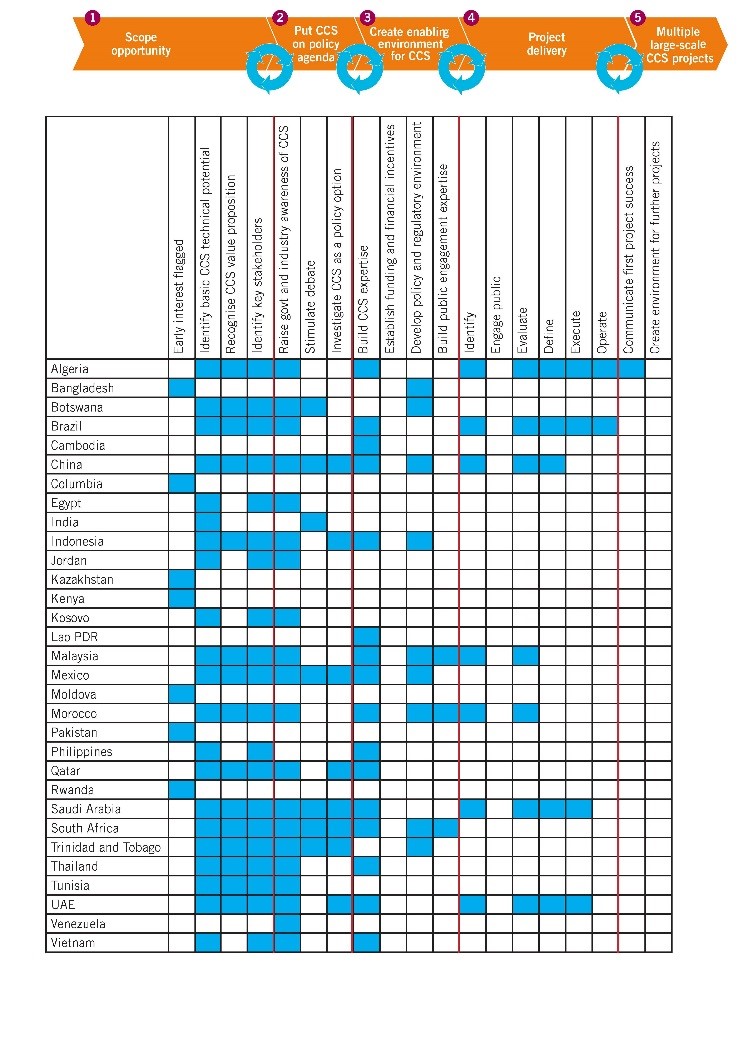Insights and Commentaries
CCS in developing countries – webinar series
15th May 2015
Topic(s): Capacity development, Carbon capture, Engineering and project delivery, Renewables, use and storage (CCUS)
A recent series of three webinars hosted by the Global CCS Institute explored the development of carbon capture and storage (CCS) in developing countries. In this Insight the Institute's Principal Manager for Capacity Development, Alice Gibson gives a summary of some of the key points in each webinar and provides links to the webinar recordings.
Deploying CCS in developing countries is critically important. The International Energy Agency (IEA) estimates that to achieve global emissions reduction targets, 70% of CCS projects will be deployed in non-OECD countries by 2050 (IEA Energy Technology Perspectives, 2012).
The Global CCS Institute therefore hosted a webinar series on ‘CCS in Developing Countries’ as a forum to discuss the status and issues in more detail. Webinars were presented by representatives of the Institute, the World Bank and the Asian Development Bank (ADB). The webinars were recorded and are now available to listen to on the Global CCS Institute website.
Key points from the webinars and the links to the three recordings are below:
CCS in Developing Countries – presented by Global CCS Institute
(click to listen to webinar)
- There are at least 24 developing countries (ie non-Annex I countries) engaged in CCS activities, such as: capacity development, pre-investment, and planning activities and project operation or development. Most are at the early stage of scoping out the opportunities and potential for CCS (Refer Figure 1 below).
- A further seven countries have shown ‘early interest’ in CCS, eg through identification of CCS in their Technology Needs Assessments under the UNFCCC.
- The Institute is aware of 16 large-scale, integrated CCS projects in non-Annex I countries that are either operational, under construction, or in the planning phases.
- There are at least seven smaller scale ‘notable’ projects in non-Annex I countries. These are either integrated, just capture or just storage projects.
- There are other ‘notable’ projects in the 'pipeline' in Indonesia, Mexico and South Africa.

Figure 1: Status of CCS in developing countries
Roadmap for CCS Demonstration and Deployment for the People's Republic of China (PRC) – presented by the ADB
(click to listen to webinar)
- The Roadmap, due to be released mid-year, identified potential targets for CCUS and CO2-EOR, including:
- 10–20 million tonnes CO2 captured and stored
- 30 million barrels of incremental oil produced through carbon dioxide ehanced oil recovery (CO2-EOR)
- The Roadmap identifies the coal chemical sector as representing the largest and lowest cost CO2 capture opportunity for the PRC.
- The PRC has significant storage potential, assessments from the Roadmap identify:
- 1300 gigatonnes (Gt) in onshore saline aquifers (theoretical capacity)
- 573 Gt in offshore saline aquifers (theoretical capacity)
- 30 Gt in gas fields (theoretical capacity)
- 5 Gt in oil fields (effective capacity)
- 216 oil and gas fields, with approximately 35 Gt of CO2 storage capacity, were ranked for storage suitability as part of the source-sink mapping undertaken as part of the Roadmap.
- Five projects (and associated potential storage sites) were identified for early stage demonstration.
- The ADB recognises that the PRC already has significant benefits to facilitate the implementation of CCS:
- wide range of technologies across the CCUS process chain pilot tested
- institutional collaborations
- strong international dialogue
- basic regulations available for early demonstration
- Ms Annika Seiler, the ADB presenter, highlighted some of the key barriers to deployment, but also the key policy actions required to support the Roadmap implementation in the PRC between 2015-2020.
Key issues and barriers in developing countries – presented by the World Bank
(click to listen to webinar)
- The World Bank presenter, Natalia Kulichenko-Lotz, highlights that climate targets in some developing countries will be difficult to achieve without CCS.
- Ms Kulichenko-Lotz indicates that CCS deployment is dependent on robust climate change policies.
- As discussed in the webinar, World Bank clients identify the following as the key barriers to CCS deployment:
- Lack of global climate change policy/internationally binding commitments in industrialised countries
- Lack of financing mechanisms
- Lack of capacity (technical and human)
- Lack of existing regulatory frameworks (long lead times to develop new or adapt the existing ones)
- Costs, cost, cost – CCS technologies are expensive, a substantial burden on national scarce resources (development agenda takes priority)
- However, on a Levelised Cost of Electricity (LCOE) basis, CCS is competitive with other low-emission technologies (based on the IPCC 5th Assessment Report).
- The World Bank CCS Trust Fund program (supported by the Institute, the United Kingdom and Norwegian Governments) initially focused on scoping opportunities in 9 countries. It is now focusing on supporting pilot projects in Mexico and South Africa. The webinar outlines the key outcomes from the World Bank’s CCS techno-economic study undertaken for South Africa.